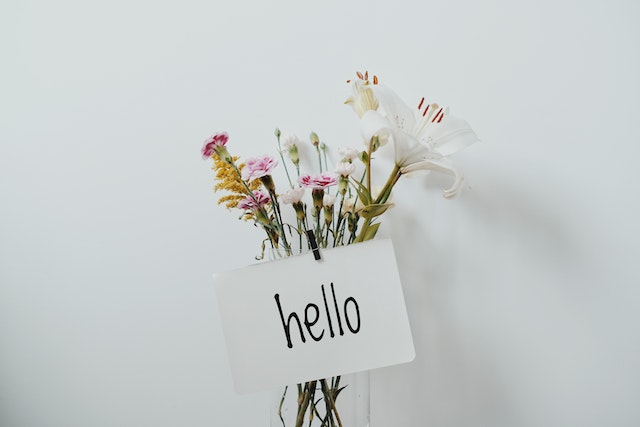Written by: Olivera Tolimir
Have you ever tried programming? Maybe it’s even your profession. Do you know the first line of code developers learn to code in a given programming language? It’s “Hello, World”!
Since we, as human beings, make machines write out “hello” when testing software, it should tell a lot about the importance of the phrase.
Also, “Hello” is the first word we memorize when learning a new (human) language. If you’ve ever learned the language, you know that “hello” in Serbian is usually “ćao”, “zdravo”, or “dobar dan”. The first is the least formal, and the “dobar dan” the most.
If you’re interested in learning to say “hello” in Serbian in new and creative ways, check out our blog post about Serbian greetings. When you finish reading, come back to learn some essential Serbian phrases beyond “hello”.

Zdravo – The Original Hello in Serbian
Zdravo is a Serbian greeting that you can use in most settings. It’s informal enough for acquaintances, and formal enough for older people. It comes from the word health. So, we wish health upon the other person. Keep reading to find out in what other greetings we have words such as health and life!
If you’d like to be more informal, use ćao (from Italian ciao). If your goal is to be as formal as you can, say Dobar dan.
Vidimo se (kasnije)!
Vidimo se is a Serbian greeting that means See you (later)! We use it instead of goodbye to close people. We usually opt for this greeting when we expect a soon encounter with the other person.
For example, we would use this phrase when making plans with our friends over the phone because we know we’ll soon see each other.
Čujemo se!
Similar to the previous one, Čujemo se directly translates as Hear you. It means I’ll hear from you soon. The phrase is often used when we don’t plan to see the other person soon but to communicate by other means (phone, social media, e-mail, etc.).
If you often text your friend from abroad but rarely video-call them, this is the phrase for you!
Živeli!
Živeli means cheers. Like many other nations, we use it during toasts. The direct translation is more similar to May we live long. You can expect to hear it approximately 32428 times at a Serbian wedding, for example.

Nazdravlje!
Nazdravlje is another word you need to learn if you plan to be polite (if you don’t plan to only say, hello in Serbian and proceeding to be quiet). It translates as Bless you. As you can assume, we use it when someone sneezes.
The fun fact about Nazdravlje is that it contains the word zdravlje (health). So, its direct translation is something along the lines of Be healthy. That’s why we use it when someone sneezes. We wish the other person not to be sick despite the fact they just showed some signs of illness.
Interestingly enough, we only use it for sneezing and not coughing! Anyway, when someone tells you Nazdravlje, you should answer with Hvala.
Nazdravlje is often mistaken for the Serbian word for Cheers because of its similarity with other Slavic languages, such as Russian, Slovak, Czech, or Bulgarian. However, that’s not the case! Instead of using Nazdravlje for cheering, remember to say Živeli!
Hristos se rodi!
Serbs have special greetings for Easter and Christmas Day. We’ve already mentioned this one in our blog post about Christmas, but it won’t hurt to repeat it. Why? Because even Serbs sometimes slip and use the Easter greeting for Christmas and vice versa. It happens because they start the same and are very specific for only two days during a year. So, in all the excitement and holiday spirit – mistakes happen.
Anyway, the greeting above is the one we use for Christmas. It translates as Christ is born. We use it instead of zdravo or dobar dan on Christmas Day.
This greeting (just like the Easter one) is a two-in-one. It means both hello in Serbian and merry Christmas.
Vaistinu se rodi!
When you hear Hristos se rodi, you answer Vaistinu se rodi! It means He is indeed born.
Hristos vaskrse! / Hristos voskrese!
These are the two variations of the Easter greeting in Serbia. It means Christ has risen. To learn more about it, check out our blog post about Easter in Serbia!
Just like with the Christmas greeting, it means both Hello in Serbian and Happy Easter. And try not to mix those two up!
Vaistinu vaskrse! / Voistinu voskrese!
Again, this is the answer to the Easter greeting in Serbian. Both versions are correct. It’s best to memorize one and always use it. There are many incorrectly written variations, but don’t pay attention. These two are the only correct versions!
The incorrect variations occur because the phrase is written in archaic language, so it doesn’t come naturally for most people.
Lepo spavaj!
Lepo spavaj is a sweeter version of a good night. It means sweet dreams.

Javi se kad stigneš!
One of the most treasured greetings of all time showing sincere care is Javi se kad stigneš. It means Let me know when you get there!
Everyone in Serbia heard this sentence a million times from their parents, friends, and partner. It shows they care for us to arrive safely wherever we go.
Prijatno!
The word prijatno has two different meanings in Serbian. You’ll find the first meaning at the end of the blog post about Serbian greetings. We use it instead of doviđenja (goodbye) in formal settings.
However, prijatno is most commonly used in other situations. We use it for the phrase have a good meal or bon appetite. So, when someone is getting ready to enjoy the meal, it’s polite to say, Prijatno!

Hvala!
“Hvala” means “thank you” in Serbian. It’s short and easy to pronounce, just like it should be. Considering how often we use it, it would be pointless to repeat something complicated.
Although, if you got bored with “hvala” (just like you find ćao to be a boring way to say hi in Serbian), prepare yourself. Read our blog post about eight new and fun ways to express gratitude in Serbian!
Nema na čemu!
When someone thanks you, it’s only polite to say, You’re welcome! Well, Serbian for you’re welcome is nema na čemu. As with the Serbian for hello, there are more ways to say you’re welcome. For example:
- (Ma) ništa! (Oh, it’s nothing!)
- Molim! (You’re welcome!)
Volim te!
Please, don’t use this phrase as soon as you say hi in Serbian! All jokes aside, volim te means I love you. So, if you have a significant other in Serbia, learn this one. It’ll melt your sweetheart’s heart to hear expressions of love in their native language!
I ja tebe!
If you use the previous phrase, it’s only fair to know what to expect in return. Unless you’re saying volim te to a random person on the street (don’t do it), there’s a big chance you’ll get an I ja tebe in return. It means Me, too (in this context: I love you, too).



